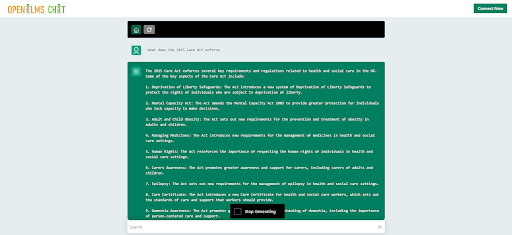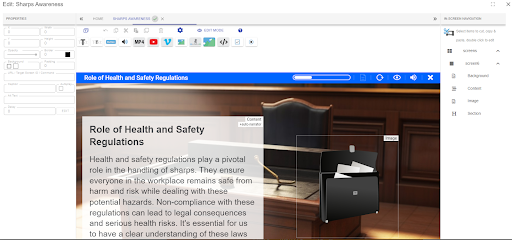Are you feeling stuck in developing engaging eLearning content? We’ve been there before, and we understand the struggle. After doing some extensive research, there is a solution: Artificial Intelligence (AI).
This article explores how AI is reshaping the landscape of eLearning content development, providing innovative ways to enhance your eLearning courses.
Key Takeaways
AI is revolutionising eLearning content development by generating and refining course materials to help best put across learning objectives.
It allows for personalised learning experiences, enhances learner engagement, and improves learning outcomes.
AI facilitates smoother content creation, cuts down on instructional design time in the elearning course development process, and enhances resource efficiency when creating an online course.
By using AI in the creation of an eLearning course, educators can create exceptional courses that effectively engage learners.

What is Artificial Intelligence (AI)?
Artificial Intelligence, often abbreviated as AI, marks a revolutionary advancement in technology. It’s a broad field of computer science dedicated to simulating human intelligence processes by machines.
Primarily this involves learning – obtaining data and rules for using the information, reasoning – applying these rules to reach approximate or definitive conclusions and self-correction.
Unlike traditional programming that requires explicit instructions for each action, AI systems can learn from experience. They might examine raw data or pre-trained models to recognise patterns and create forecasts based on that knowledge.
For instance, it allows our phones to recommend new songs or movies based on what we’ve previously enjoyed. In the realm of e-learning content development, AI has immense potential which would be discussed later in this article.
Types of AI-generated Content for Digital Customer Education
We want to shed light on the diverse types of AI-generated content used in digital customer education.
Personalised course recommendations: AI uses data from past courses to suggest new relevant ones.
Adaptive learning paths: These let learners progress at their own pace, adjusting material based on their performance.
Interactive video lessons: AI can create engaging elearning content, interactive video for visual learners.
Automated voiceovers: With natural speech recognition, AI can produce automated voiceovers for audio content.
Real-time language translation: Enables accessibility for a global audience by translating course material into various languages.
Virtual assistants or chatbots: These help answer queries, provide additional resources, improving learner engagement.

What Are the Benefits of AI-assisted Content Development?
Harnessing the power of artificial intelligence drastically improves e-learning course development in multiple ways. Here are a few remarkable benefits:
Allows for Tailored Learning Experiences: AI gives us the tools to personalise educational content to match the learning style and pace of individual learners.
Enhances Learner Engagement: Engaging learners becomes more manageable with customised feedback, and personalised learning paths facilitated by AI.
Streamlines Content Creation: AI accelerates the development process by generating written content, creating graphics and editing videos swiftly and efficiently.
Improves Learning Outcomes: Intelligent algorithms can analyse learner progress and adjust course materials on-the-fly to optimise outcomes based off of a learning objective.
Facilitates Continuous Improvement: With AI’s data crunching capabilities, we can derive actionable insights to continuously refine our e-learning courses.
Boosts Scalability: Thanks to automated generation of e-learning content, we can scale up training program delivery without compromising on quality to create s successful elearning project.
Reduces Instructional Design Time: Advanced authoring tools powered by AI reduce the time it takes instructional designers to develop an entire course from start to finish.
Delivers Consistent Training Content: Automated content creation ensures consistency across all training modules – a critical factor for successful e-learning projects.
Enables Real-Time Assistance & Feedback: Virtual tutoring and real-time assessment become possible with AI, enhancing learners’ grasp of knowledge and skills during the learning process.
Promotes Efficient Resource Utilisation: By streamlining various stages of the e-learning course development process, AI allows team leaders and instructional designers to focus more on critical tasks like setting training goals or understanding learner needs better.
How to Use AI to Create Great Course Content
To use AI in creating exceptional course content, we follow a simple process. First, we define our goals and learning objectives for the course. Next, we gather data and information from subject matter experts to ensure accuracy and relevance.

Once we have the necessary information, AI assists us in generating custom elearning courses that are tailored to our intended audience. We then edit and refine the content to enhance clarity and engagement.
Finally, after thorough review, we publish and promote the course to reach as many learners as possible. By utilising AI in these steps, we can create online courses that effectively engages learners and meets their learning needs.
Define Goals and Objectives
Defining goals and objectives is a crucial step in developing e-learning content. By clearly identifying what you want to achieve, you can create targeted and effective courses that meet the needs of your learners.
Start by asking yourself what specific skills or knowledge you want your learners to gain from the course. These goals should be measurable and aligned with your overall training objectives.
Next, consider the learning outcomes you expect from the course. These are statements that describe what learners will be able to do after completing the course. By setting clear goals and objectives, you can ensure that your e-learning content is focused, relevant, and impactful for your audience.
When defining goals and objectives for your e-learning courses, it’s important to involve key stakeholders such as subject matter experts (SMEs) and instructional designers.
They can provide valuable input on what topics should be covered, the level of complexity required, and any specific requirements or constraints to consider during development.
This collaborative approach ensures that all perspectives are taken into account when setting goals and objectives for your e-learning content.
In summary, defining clear goals and objectives is an essential part of developing successful e-learning courses. It helps guide the creation process by identifying what skills or knowledge learners need to acquire and outlining measurable learning outcomes.
By involving stakeholders in this process, you can ensure that your e-learning content meets their expectations while also aligning with broader training objectives.
Gather Data and Information from Subject Matter Experts (SMEs)
To gather data and information from subject matter experts (SMEs), we follow a systematic approach:
-Identify the SMEs who possess the necessary knowledge and expertise for the topic.
-Schedule interviews or meetings with the SMEs to discuss the content requirements.
-Ask targeted questions to elicit detailed information and insights from the SMEs.

-Take notes or record the conversations to capture all relevant details.
-Request any supporting materials, research papers, or resources from the SMEs.
-Collaborate with the SMEs to review and validate the collected information.
-Clarify any uncertainties or seek further explanation when needed.
Generate Your Content
To generate your content for e-learning courses, start by organising the information and data gathered from subject matter experts (SMEs). Use this knowledge to create engaging course materials that align with your goals and objectives.
Utilise various tools and platforms to develop written content, graphics, videos, and interactive learning activities. Ensure that the content is relevant and tailored to your target audience.
Collaborate with a team of instructional designers, authors, graphic designers, and video editors to bring your course to life. By generating high-quality content using AI-assisted methods, you can create effective online training programs that engage learners and achieve desired learning outcomes.
Edit and Refine
After generating your content with the help of AI, it’s important to spend time editing and refining it. This step ensures that your e-learning courses are polished and error-free before being presented to learners.

Start by reviewing the content for grammar and spelling mistakes, making necessary corrections along the way.
Next, focus on improving the clarity and organisation of your course material. Break down complex concepts into smaller, more digestible sections and ensure a logical flow between them.
Consider adding relevant visuals or multimedia elements to enhance engagement.
In addition, pay attention to the tone and style of your content. Aim for a conversational yet professional tone that resonates with your target audience.
Avoid using technical jargon or overly complex language that might confuse learners.
Finally, test your course yourself or have someone else go through it as a fresh pair of eyes can spot errors or inconsistencies you may have missed.
Take their feedback into account and make any necessary revisions before proceeding to the next phase of publishing and promotion.
Publish and Promote
Once we have edited and refined our AI-generated content, it’s time to publish and promote it. We can use various platforms such as learning management systems or online course marketplaces to make our e-learning courses accessible to learners.
By publishing the courses, we give learners the opportunity to engage with the content and benefit from their learning experience.
Promoting our e-learning courses is essential for reaching our target audience. We can leverage social media platforms, email marketing campaigns, or partnerships with relevant organisations or influencers in the industry.
Promotional activities help us generate interest and drive traffic towards our courses, allowing more learners to discover and enrol in them.
In summary, publishing and promoting our AI-assisted e-learning content is crucial for making it available to learners and ensuring its success.
By utilising different platforms and promotional strategies, we increase the chances of attracting a wider audience who will benefit from our valuable educational resources.
Final Thoughts: The Power of AI in eLearning Development
To sum up, AI is significantly impacting the evolution of eLearning content development. With its ability to generate and refine course materials, AI offers a solution for those feeling stuck in the content creation process.
By harnessing the power of AI, educators can create engaging and effective online courses that meet the needs of learners. So, don’t be afraid to explore how AI can transform your eLearning content development and take your courses to the next level.
